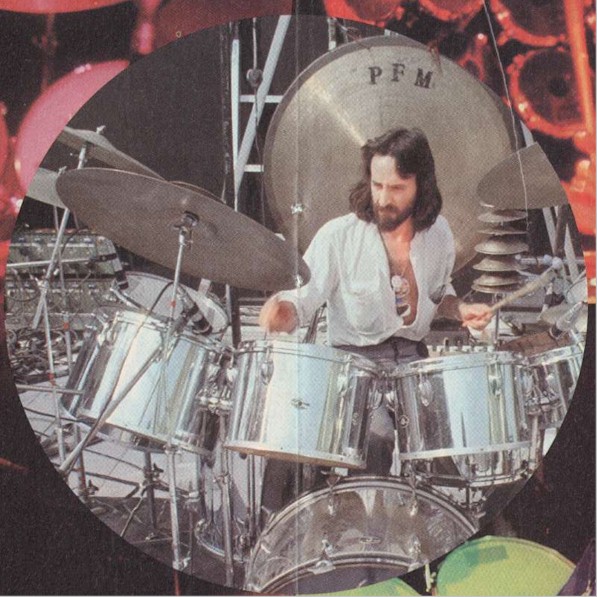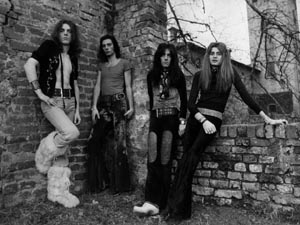At the end of the Sixties in Italy Mersey Beat”, completely different from the American Beat Generation phenomenon. In Italy “Beat” means simple, carefree songs, with clear harmony vocals on “beating” rhythms to dance to, songs in their way revolutionary, inspired by the Beatles, Rolling Stones, Yardbirds, Animals and Hollies. To take inspiration here means producing cover versions, transposing foreign songs to make new pieces [1]. The phenomenon of cover versions, the remake of a song with lyrics translated into Italian, has deep roots. It dates back to the ‘30s, a time when Italy Italy
 |
| Franz Di Cioccio |
Franz Di Cioccio, drummer of Premiata Forneria Marconi: - Italian beat was also a phenomenon of emulation, often more focused on the look than on the music. If you pick up a record and you copy it as it is it’s not like being The Troggs or The Traffic or The Yardbirds that have in their line-ups three of the greatest guitarists in rock history (Eric Clapton, Jeff Beck and Jimmy Page). They used to write their pieces and shape their sound. In our country this phenomenon was typically Italian. Italian song takes in everything and phagocytes it, and it’s a classic. When a phenomenon becomes a phenomenon it is incorporated, it is exploited both from an economic and from a social point of view and everything becomes watered down and diluted. Once you have put your hands on the phenomenon and you have exploited it, you turn to something else. Musicians who believed in their music went on while others were convinced that they could go on just changing look and working without effort [4].
Many Italian progressive rock bands of the first wave began their career as “Beat bands”, though sometimes with different names, as, for instance, Le Orme, Premiata Forneria Marconi (I Quelli), Banco del Mutuo Soccorso, I New Trolls, Delirium (I Sagittari), I Giganti, Metamorfosi (Frammenti), Il Balletto di Bronzo, I Califfi, I Dik Dik and many others. “Pop music” at that time in Italy London Ricevuta di Ritorno , Il Ritratto di Dorian Gray, Samadhi and DGM: - In the little Roman scene at the end of the sixties it was difficult to hear music from England
Franz Di Cioccio: - There’s no specific date that marks the beginning of the first wave of Italian Progressive Rock in the Seventies. Musical influences were coming from England Isle of Wight festival, it was clear to all of us that we couldn’t keep on playing the usual songs with verses and refrains [10]. Le Orme’s album had an extraordinary and unexpected success and immediately many other bands followed with other albums in the same style, as Premiata Forneria Marconi, I New Trolls, Delirium, Osanna or Banco del Mutuo Soccorso. Vittorio Nocenzi, keyboardist of Banco del Mutuo Soccorso: - BMS’ project came to life when I was only eighteen, with the first line-up and the will to find a bridge between the “Beat generation” and the need for a new musical synthesis on the paths of classical music where I had already walked... [11].
 |
| Il Balletto di Bronzo |
The Golden Age of Italian Progressive Rock was rising. Gianni Leone, keyboardist and singer of Il Balletto di Bronzo: - In Italy they began to speak of progressive rock during a pop festival in Novate, near Milan del Luxembourg
[1] D. ZOPPO, Premiata Forneria Marconi, 1971-2006: 35 anni di rock immaginifico, ed. Editori Riuniti, Roma, 2006, p. 18.
[2] In 1924 the National Fascist Party ordered that songs in foreign languages had to be translated to be performed in Italy
[3] See R. IURZA, Il Beat... cos’è?, Puleio Press, Milano, 2006, p. 68
[4] Quote from an interview in T. TARLI: Beat Italiano – dai capelloni a Bandiera Gialla, 2^ ed., Castelvecchi, Roma, 2007, pag. 273
[5] M. COTTO, Di acqua e di respiro, Ivano Fossati si racconta a Massimo Cotto, ed. Arcana, Roma, 2005, p. 13.
[6] C. RIZZI, Progressive, ed. Giunti, coll. Atlanti Universali, Firenze, 1999, p. 6
[7] Quote from an interview on the site www.ilpopolodelblues.com
[8] Quote from G. CASIRAGHI, Anni 70 – Generazione Rock, Ed. Riuniti, Roma, 2005, p. 41.
[9] See for instance M. FORNI, Lungo le vie del prog – Storia del rock progressivo italiano. Personaggi e opere dal 1971 al 2008, Palladino Editore, Campobasso, 2008, p. 22-23.
[10] Quote from G. CASIRAGHI, Anni 70 – Generazione Rock, Ed. Riuniti, Roma, 2005, p. 128.
[11] Quote from an interview on the site www.pagine70.com.
[12] Quote from F. MIRENZI, Rock Progressivo Italiano - Vol. 2, ed. Castelvecchi, Roma, 1997
No comments:
Post a Comment